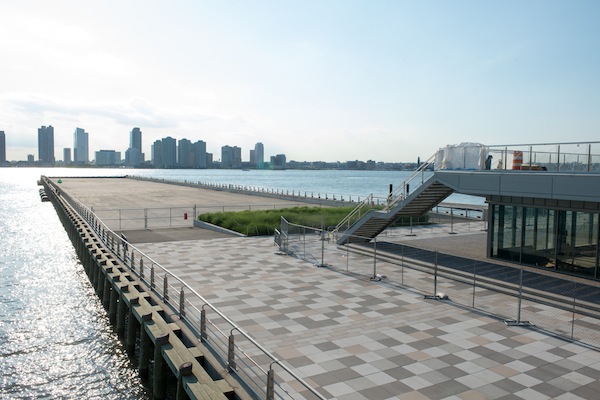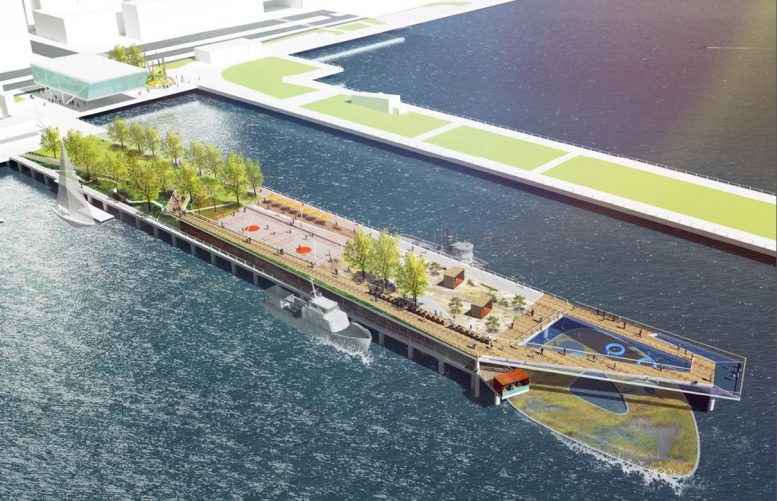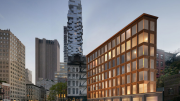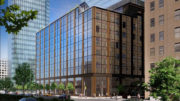New renderings have been revealed of the Hudson River Park Trust’s plans to transform the mostly vacant, 800-foot-long Pier 26, located in the Hudson River off TriBeCa, between North Moore and Hubert streets, into a public park. The $30 million overhaul would include a maritime education center, known as an estuarium, multiple landscaped areas with different kinds of vegetation, walking paths, seating, and playgrounds. The overhaul is getting equal financing from the city, the Lower Manhattan Development Corporation, and Citigroup, through a donation. OLIN Studio, a landscape architecture firm, is designing much of the pier, although Rafael Viñoly’s firm is designing the estuarium building. The plans are not final, although construction is anticipated to begin in roughly a year, Tribeca Citizen reported.

Present-day Pier 26. Photo by Julienne Schaer for Downtown Express
Subscribe to YIMBY’s daily e-mail
Follow YIMBYgram for real-time photo updates
Like YIMBY on Facebook
Follow YIMBY’s Twitter for the latest in YIMBYnews






Keep clean an environment be fresh views, worth while with plans on Pier 26 be able into public park.
I find his to be a sad design that could be an equal-sized park somewhere on land.
Its “forest”, play space, “dune” grassland, etc., avoid engaging the living, changing river in a meaningful way. Despite the inclusion of a pier-end steel mesh “lounge”, the overall design focuses on a program of uses and urban park conventions, rather than this unique “place”. Aside from its existing views of the sky and river-sweep, most of it could be located within the buildings of Battery Park City, or in Philadelphia.
What is this place?
This river is alive. It is an immense complex of tidal, seasonal, and weather-related events
— and human activity — that profoundly influence the water and the creatures that live in it. It is based on water-born plants and animals that sustain all life on earth. The nature of the Estuary is as fascinating and profound – and hidden – as any place in nature.
Mere blocks from the World Trade Center and its diverse memorials, Pier 26 can offer an intimate encounter with the intelligence in nature if we provide a means to observe it. It can help remedy our increasingly over-designed City and our collective need for greater ecological awareness in a time of rapid species depletion and perilous climate change. These are needs that will only increase in the years ahead.
The Estuarium should be the focus of Pier 26 and should be located upon it and well offshore, with ample deck and dockside space to enable the netting, collecting and study, dive support and small boat use, water sampling and other research activities that are part of an exciting marine research and education program that engages the public. The Clearwater should be part of this program.
Think Woods Hole.
To reveal the intense life and ecology of this place, river water should be pumped up to deck-level to flow through aquarium tanks that display river creatures and how they interact with one another and with the brackish tidal water that changes day to day and hour to hour. The River Project pioneered this Estuarium concept on Pier 26 in 1986 on a shoestring budget, and helped to establish the Hudson River Park Estuarine Sanctuary that now extends to 59th Street. There is no other program in New York or in the world that offers such an intimate and in-depth experience of the living environment in such close proximity to its urban setting.
Olin’s concept design locates the Estuarium in a box next to a noisy highway and a fantasy playground that offer little contact with the water. Their pier and pathway offer a series of encounters with artificial landscape zones that are largely a repeat of the adjacent Pier 25. None of these experiences provide a view of the life beneath the water’s surface, nor any insights about what is hidden in this place. Why limit our vision to a conventional list of park amenities on Pier 26 that repeats what is available nearby in the Park and ignores the potential to connect with the gigantic living space that surrounds it?
Out on the pier’s end, surrounded by water, it may be that walking or sitting on an open-mesh surface 10-15 feet above the water will provide a physical thrill and a memorable encounter with the water’s surface action. Given this river’s nature, this may rarely be restful or likely to invite a person to linger. Visitors can already observe this on the open meshes of the East River Park at Wall Street. This restless tendency may be especially true above an artificial wetland, if we are to imagine the oyster shoals, insects, floating trash and periodic effluents that are natural to this location.
I hope that all the designers and stakeholders that are involved in this worthy project will recognize that Pier 26 represents an opportunity for the public to encounter the living river above and below the water’s surface and a legacy for future generations that we cannot squander on a conventional menu of urban park amenities. There will never again be such an opportunity to access the life in this location which is so important to New York City and the world.
Hudson River Trust and BPCA need to be completely gutted of their cronyism , bribes for political favors